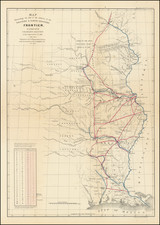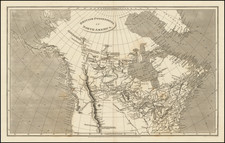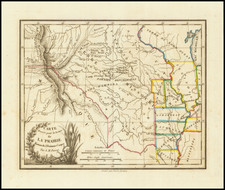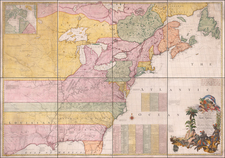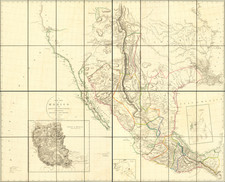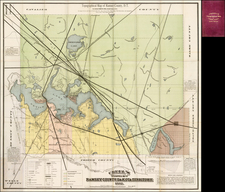Fine watercolor illustration of St. Charles, Missouri, on the Missouri River, the first State Capital of Missouri, illustrating the expedition of Friedrich Paul Wilhelm, the Fifth Duke of Württemberg, up the Mississippi and Missouri Rivers in 1822-1824.
Wilhelm is one of the most important explorers of the Upper Mississippi and Missouri Rivers. On his second expedition to America, Wilhelm would go on to discover the headwaters of the Missouri in 1829. The present sketches would appear to have been constructed either on the spot or from sketch books brought back from the expedition, possibly in preparation for the use as illustrations in Wilhelm's published account of his expedition. The present sketch is one of two acquired in Germany in 2012, the second, La Balise, would in fact be used to illustrate Wilhelm's account and is listed in Deak's Picturing America (#334).
St. Charles, Missouri was an important town in the early exploration of the Transmississippi West. St. Charles was described as the last civilized stop on the Lewis & Clark expedition's travels westward in 1804. It would later serve as the first State Capital of the State of Missouri from 1821 to 1826. The present illustration was drawn at approximately the mid-point of this 5 year period.
Friedrich Paul Wilhelm, the Fifth Duke of Württemberg, made his first expedition to the United States in years 1822-24, which he described in his diary published in 1835 ( Reise nach dem nördlichen Amerika in den Jahren 1822 bis 1824).
Between the years 1822 to 1824, Paul Wilhelm's undertook his first major research trip to Cuba and North America. His diary described the places he visited in great scientific and ethnological detail. Wilhelm arrived in New Orleans in December 1822. His party took a riverboat up the Mississippi to St. Louis, where the Prince met with the Superintendent of Indian Affairs, William Clark, who granted him a passport into the interior country. Wilhelm was also introduced the son of Sacagawea, Jean Baptiste Charbonneau.
After his initial meeting with Jean Baptiste Charbonneau in 1823 at the Kansas River, Wilhelm left camp and headed north with Great Plains veteran Toussaint Charbonneau, Jean Baptiste's father and Sacagawea's husband, hired as an interpreter. The Duke's party spent five months in the upper Missouri country visiting trading forts, Indian tribes, and collecting scientific data.
St. Charles was founded in 1769 by Louis Blanchette. As noted by Stephen Long, by the time of Lewis & Clark, this town featured "a Chappel, one hundred dwelling houses, and about 450 inhabitants[.]" Lewis noted that "These people are principally the descendants of the Canadian French, and it is not an inconsiderable portian [sic] of them that can boast a small dash of the pure blood of the aboriginees of America." While founded as a fur trading location, an agriculturally based brick town had begun to emerge by the time Paul Wilhelm visited in 1823.
Duke Friedrich Paul Wilhelm of Württemberg (1797 – 1860 ) was a member of the House of Württemberg and a Duke of Württemberg.
Paul Wilhelm was a German naturalist and explorer, who in the early 19th century, undertook several expeditions in North America, North Africa, and Australia. In 1829, he discovered the sources of the Missouri River.
Between the years 1822 to 1824, Paul Wilhelm's undertook his first major research trip to Cuba and North America. He kept a diary in which he described the places he visited in great scientific and ethnological detail. An artist produced numerous images of the landscapes, plants, and animals.
Paul Wilhelm devoted himself particularly to the study North and South America. He spent time exploring the Western United States and met the son of Sacagawea, Jean Baptiste Charbonneau. After his initial meeting with Jean Baptiste Charbonneau in 1823 at the Kansas River, likely arranged by William Clark, Paul Wilhelm left camp and headed north with Great Plains veteran Toussaint Charbonneau, Jean Baptiste's father and Sacagawea's husband, hired as an interpreter.
The Duke’s party spent five months in the upper Missouri country visiting trading forts, Indian tribes, and collecting scientific data. Paul Wilhelm is traditionally included as one of the first explorers of the headwaters of the Mississippi and Missouri rivers.
As late as the 1850s, he visited Baron Ottmar von Behr, a German farmer and sheep breeder, meteorologist, and scientist living in Sisterdale, Texas. When he visited New Braunfels on an 1855 visit, artist Carl G. von Iwonski made him a gift of six pencil sketches of the artist's Texas work.









